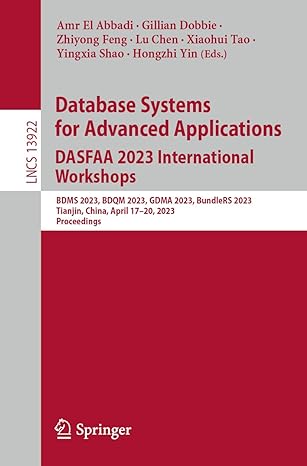Question
Here is a C++ class definition for an abstract data type LinkedList of string objects. Implement each member function in the class below. Some of
Here is a C++ class definition for an abstract data type LinkedList of string objects. Implement each member function in the class below. Some of the functions we may have already done in lecture, that's fine, try to do those first without looking at your notes. You may add whatever private data members or private member functions you want to this class.
#include
#include
Using namespace std;
typedef string ItemType;
Struct Node {
ItemType value;
Node *next;
};
Class LinkedList {
private:
Node *head;
public:
// default constructor
LinkedList() : head(nullptr) { }
// copy constructor
LinkedList(const LinkedList& rhs);
// Destroys all the dynamically allocated memory
// in the list.
~LinkedList();
// assignment operator
const LinkedList& operator=(const LinkedList& rhs);
// Inserts val at the rear of the list
void insertToRear(const ItemType &val);
// Prints the LinkedList void
printList() const;
// Sets item to the value at position i in this
// LinkedList and return true, returns false if
// there is no element i
bool get(int i, ItemType& item) const;
// Reverses the LinkedList
void reverseList();
// Prints the LinkedList in reverse order
void printReverse() const;
// Appends the values of other onto the end of this
// LinkedList.
void append(const LinkedList &other);
// Exchange the contents of this LinkedList with the other
// one.
void swap(LinkedList &other);
// Returns the number of items in the Linked List.
int size() const;
};
When we don't want a function to change a parameter representing a value of the type stored in the LinkedList, we pass that parameter by constant reference. Passing it by value would have been perfectly fine for this problem, but we chose the const reference alternative because that will be more suitable after we make some generalizations in a later problem.
The get function enables a client to iterate over all elements of a LinkedList. In other words, this code fragment
LinkedList ls;
ls.insertToRear("Carl");
ls.insertToRear("Hariette");
ls.insertToRear("Eddie");
ls.insertToRear("Laura");
ls.insertToRear("Judy");
ls.insertToRear("Steve");
for (int k = 0; k < ls.size(); k++)
{
string x;
ls.get(k, x);
cout << x << endl;
}
must write
Carl
Hariette
Eddie
Laura
Judy
Steve
The printList and printReverse functions enables a client to print elements of a LinkedList. In other words, this code fragment
LinkedList ls;
ls.insertToRear("Cory");
ls.insertToRear("Topanga");
ls.insertToRear("Shawn");
ls.insertToRear("Eric");
ls.printList();
ls.printReverse();
must write
Cory Topanga Shawn Eric
Eric Shawn Topanga Cory
You should have one space between after each item printed with an additional newline after the last item. Here is an example of the append function:
LinkedList e1;
e1.insertToRear("devoe");
e1.insertToRear("biv");
e1.insertToRear("bell");
LinkedList e2;
e2.insertToRear("Big Boi");
e2.insertToRear("Andre");
e1.append(e2); // adds contents of e2 to the end of e1
string s;
assert(e1.size() == 5 && e1.get(3, s) && s == "Big Boi");
assert(e2.size() == 2 && e2.get(1, s) && s == "Andre");
Here is an example of the reverseList function:
LinkedList e1;
e1.insertToRear("Norm");
e1.insertToRear("Cliff");
e1.insertToRear("Carla");
e1.insertToRear("Sam");
e1.reverseList(); // reverses the contents of e1
string s;
assert(e1.size() == 4 && e1.get(0, s) && s == "Sam");
Here's an example of the swap function:
LinkedList e1;
e1.insertToRear("D");
e1.insertToRear("C");
e1.insertToRear("B");
e1.insertToRear("A");
LinkedList e2;
e2.insertToRear("Z");
e2.insertToRear("Y");
e2.insertToRear("X");
e1.swap(e2); // exchange contents of e1 and e2
string s;
assert(e1.size() == 3 && e1.get(0, s) && s == "Z");
assert(e2.size() == 4 && e2.get(2, s) && s == "B");
When comparing items, just use the == or != operators provided for the string type by
the library. These do case-sensitive comparisons, and that's fine.
The files are restricted to linkedlist.h , linkedlist.cpp , and main.cpp. The header file linkedlist.h will contain all the code from the top of this specification (includes, typedef, struct Node, class LinkedList) and proper guards, while the C++ file linkedlist.cpp will contain the LinkedList member functions you will write. The main file main.cpp can have the main routine do whatever you want because we will rename it to something harmless, never call it, and append our own main routine to your file. Our main routine will thoroughly test your functions. You'll probably want your main routine to do the same. Your code must be such that if we insert it into a suitable test framework with a main routine and appropriate #include directives, it compiles. (In other words, it must have no missing semicolons, unbalanced parentheses, undeclared variables, etc.)
Step by Step Solution
There are 3 Steps involved in it
Step: 1

Get Instant Access to Expert-Tailored Solutions
See step-by-step solutions with expert insights and AI powered tools for academic success
Step: 2

Step: 3

Ace Your Homework with AI
Get the answers you need in no time with our AI-driven, step-by-step assistance
Get Started


